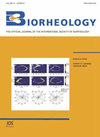投稿信息
投稿信息
审稿周期
投稿命中率
审稿费用
暂无数据
版面费用
暂无数据
中国人发表比例
2022年中国人文章占该期刊总数量50.00% (2019年为11.11%)
自引率
4.0 %
年文章数
1309
作者需知
暂无数据
NCBI查询
偏重的研究方向
暂无数据
期刊简介
稿件收录要求
稿件收录要求
Biorheology is an international interdisciplinary journal that publishes research on the deformation and flow properties of biological systems or materials.The aim of biorheological research is to determine and characterize the dynamics of physiological processes at all levels of organization. Manuscripts should report original theoretical and/or experimental research promoting the scientific and technological advances in a broad field that ranges from the rheology of macromolecules and macromolecular arrays to cell, tissue, and organ rheology. In all these areas, the interrelationships of rheological properties of the systems or materials investigated and their structural and functional aspects are stressed. Through biochemical reactions, biological systems are able to generate forces that are harnessed by means of structures that function as "molecular machines." These forces can produce motions and flows that are matched to the functional purpose of each particular biological system. Biorheological investigations are aimed at understanding how this matching is achieved, given that the material properties of the mechanical systems involved are known or have been determined as part of the study. Based on the assumption that evolutionary selection has resulted in optimal solutions, a major question asked in biorheology is if the evolved structures and the rheological characteristics of the system under study are indeed optimized. Discrepancies on this score raise the question whether indeed all the functional features of the physiological process considered have been properly understood and taken into consideration. The scope of papers solicited by Biorheology extends to systems at different levels of organization that have never been studied before, or, if studied previously, have either never been analyzed in terms of their rheological properties or have not been studied from the point of view of the rheological matching between their structural and functional properties. This biorheological approach applies in particular to molecular studies where changes of physical properties and conformation are investigated without reference to how the process actually takes place, how the forces generated are matched to the properties of the structures and environment concerned, proper time scales, or what structures or strength of structures are required. Biorheology invites papers in which such "molecular biorheological" aspects, whether in animal or plant systems, are examined and discussed. The rheology of macromolecular arrays encom-passes the dynamics, topology, and swelling properties, as well as modeling, of biopolymer networks. It also includes the rheological characterization of biogels, their swelling properties, and phase transition characteristics.




